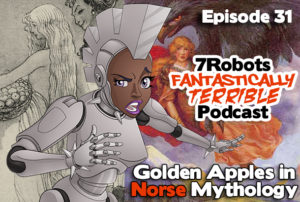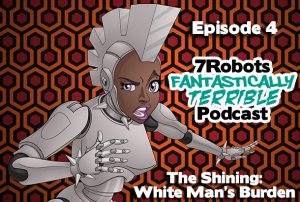How to Listen
The best way to support the show is to like our episodes and follow us. You don’t know how much this helps us out! Liking each episode you enjoy let’s us know…that you liked it. So, if you like our work, we’ll keep doing it. Woohoo!
If you go that extra mile and leave a comment, we can see your name and personally thank you live at the end of show! 
(⌐■_■)ノ♪♬ Script and music by Suzy Dias
Listen here:


Watch our mini documentaries:
Latest News and Episodes
Get all the latest episodes, breaking news, opinions, weather, traffic, and more…Um, minus the weather and traffic and add a lot of laughs. 
Listen or watch on YouTube
Episode 35: A History of the End of the World
People think of the end of the world as a singular event. After all, it is THE END. But humans are nothing if not creative about their own destruction. The ultimate annihilation, the end of the world, armageddon or the apocalypse has a long history. It seems the end is always near.
However, to characterize all of past religions as believing in the end of days is incorrect. Most look at eras in stages and cycles, some better than others, but all leading to a chance at renewal. We often get bogged down in our western beliefs and think that that everyone thinks the same way.
With that in mind, this show is absolutely focussed on the major religions that believe in a final judgement from which no one can escape. Not at the end of your life, like the Egyptians, but the end of the world as we know it.
We’re going to look at the history of the end of the world. What are the most dramatic examples of the end of the world?
Hinduism
Hinduism is a very fluid belief system that unites related religious traditions native to India. It has traditions that date back to the Bronze and Iron Ages, which is why it’s the world’s oldest religion. [read more…]
This is from History.com: “In Hinduism, there is the story of the god Vishnu coming back in the last cycle of time as a figure called Kalki, who rides a white horse, carries a sword that looks like a comet and destroys the forces of evil. In some Buddhist prophecies, the equivalent of Armageddon is Shambhala, in which good triumphs over evil; however, the planet is restored rather than destroyed so people can pursue enlightenment.” [read more…]
This is from BBC Religions: “Brahma is the creator of the universe and Shiva is the destroyer. Vishnu is the preserver and protector of the universe. His role is to return to the earth in troubled times and restore the balance of good and evil. So far, he has been incarnated nine times, but Hindus believe that he will be reincarnated one last time close to the end of this world.” [read more…]
From Wikipedia on Hindu eschatology: “The current period is Kali Yuga, the last of four Yuga that make up the current age. It started just after Krishna left the earth in human form, in almost 3102 BCE or 5123 years from 2021. Each period has seen a progressive decline in morality, to the point that in Kali Yuga quarrel and hypocrisy are norm.” [read more…]
We’ll see this theme repeated throughout all religions. This idea that morality is in progressive decline and at some point, will need a Messiah or Savior to bring balance.
LINKS
★ Religions on the End of the World
★ Vishnu
★ Hinduism
Zoroastrianism
The ancient Persian religion of Zoroastrianism dates from around the 6th or even the 10th century BCE. It’s at least 3500 years old. The main apocalyptic text is the “Zand-i Wahman Yasn”, which dates to the early 15th century BCE. These writings describe several key events in which their God, Ahura Mazda (Lord of Wisdom), reveals the truth to the prophet Zarathustra. Since this region predates Judaism, you’ll notice many similarities, including the idea of Monotheism:
- Worsening climate changes that lead to famine and nearly unlivable conditions on planet
- People become increasingly wicked
- A final battle between good and evil, including a final clash between the forces of Heaven and Hell and the angels and demons
- The arrival of a savior known as Saoshyant
- A resurrection of the dead
- The physical suffering of wicked people
- The righteous are transformed into a divine, immortal state
- Humanity living with the one true God
The main teachings were from the prophet Zoroaster (or Zarathustra), who historians believe lived between the 10th and 6th centuries BCE. From what we know, these were the first believers in a prophesy about a Messiah. Their world savior was named Saoshyant. This righteous wise one will defeat evil and the re-establishment of truth and virtue in the end times.
In the Zoroastrian scriptures, Zarathushtra asked God, “How much time remains until the time of the making all things new and perfect, … and the Future Body?’ God said: ‘3,000 years’.” [read more…]
So, how much time do we have left according to Zoroastrianism? Their prophet Zarathushtra is believed to have lived some time between 1200BC and 1000BC, which would roughly mean the present day.
And according to Zarathushtra, how will the world end? He noted a comet will collide with the Earth and melt the hills and the mountains. God will lock up the evil spirit. The comet’s fire will burn the evil serpent and hell itself.
We now know that the dinosaurs were wiped out by such an event about 65 million years ago. We also know that such collisions have caused mass extinctions periodically over the millennia.
I’ll tie this into a modern version of the prophecy. In 1997, Michael Drosnin published a very popular book called “The Bible Code” which described such a collision hitting the Earth. So, it looks like Zarathushtra may still be relevant today to those looking for the end of the world.
LINKS
★ Zoroastrianism
★ The obscure religion that shaped the West
★ Zoroastrianism, Abrahamic Religions and the End of the World
★ Persian Empire
Assyrian Empire
The earliest prediction of the end of the world comes from the Assyrians, a powerful Mesopotamian culture that lasted for about two thousand years. A tablet was found dating back to sometime between 2800 and 2500 BCE that bears the first known prophecy of the end of days. According to the translation, it claims that the earth was in its final days in those years and warned,
“Our Earth is degenerate in these later days; there are signs that the world is speedily coming to an end; bribery and corruption are common; children no longer obey their parents; every man wants to write a book and the end of the world is evidently approaching.”
I’m struck by two things – this could have been written today. All of these complaints are common in our present day. But naughty children aside, we’re still here. The Assyrian empire lasted for for almost 2000 years, which was a pretty good run and nothing to complain about. [read more…]
LINKS
Judaism
Judaism dates back to about the 9th to 5th century BCE, approximately 4000 years ago. Does Judaism have an end of the world belief?
Most Jews believe in the Moshiach (messiah: Hebrew for “the anointed one”). This long awaited Jewish leader will usher in an era of world peace and Godly awareness. He will be a descendant of King David who will lead the Jewish people back to the Land of Israel and rebuild the Temple in Jerusalem. All leaders of the world will acknowledge the dominion of this Messiah, creating a new era of international peace and prosperity that will endure forever. Jewish scripture refers to this period as the Messianic period.
The religion morphed into its current form in the 6th century BCE. “Two of the most fundamental tenets of the Jewish faith – as listed by Maimonides among the Thirteen Principles of the Jewish Faith – are the belief in the ultimate redemption, an awaited era of world peace, prosperity and wisdom, and the belief that the dead will be resurrected at that time.” [read more…]
Maimonides
The “Maimonides” was written in the Middle Ages by Rabbi and doctor, Moses ben Maimon or Rambam, who lived from 1138–1204. He was Sephardic jew born to a distinguished family in in Cordova, Spain, but lived most of his life in Egypt [read more…]
This is from Haaretz.com: “Early Judaism had no tradition of the world ending in a day of divine judgment. No such notion appears in First Temple-period material in the Hebrew Bible. But the idea does suddenly appear in prophetic books penned after the late 6th century B.C.E.
For example: “Many nations will be joined with the Lord in that day and will become my people. I will live among you and you will know that the Lord Almighty has sent me to you” (Zechariah 2:11).” [read more…]
The Jewish tradition has many opinions on the subjects of heaven and hell although they’re not obsessed with the idea.
There are several biblical references to a place called Sheol, such as Numbers 30 and 33. It is described as a region “dark and deep,” “the Pit,” and “the Land of Forgetfulness.” It’s pretty bleak. The books of Ecclesiastes and Job insist that all of the dead go down to Sheol, whether good or evil, rich or poor, slave or free man (Job 3:11-19). [read more here…and here.]
Not at all the same the Christian or Muslim belief. Later, preeminent Rabbis claimed that the righteous are made to suffer in this world so that their reward will be that much greater in the next (Leviticus Rabbah 27:1). [read more…]
Gan Eden
This is from My Jewish Learning…
They do speak Gan Eden (“the Garden of Eden”), referring to a heavenly realm where souls reside after physical death.
“The use of the term Gan Eden to describe “heaven” suggests that the rabbis conceived of the afterlife as a return to the blissful existence of Adam and Eve in the Garden of Eden before the “fall.” It is generally believed that in Gan Eden the human soul exists in a disembodied state until the time of bodily resurrection in the days of the Messiah…
Only truly righteous souls ascend directly to the Garden of Eden, say the sages. The average person descends to a place of punishment and/or purification, generally referred to as Gehinnom….
Some view Gehinnom as a place of torture and punishment, fire and brimstone. Others imagine it less harshly, as a place where one reviews the actions of his/her life and repents for past misdeeds. The soul’s sentence in Gehinnom is usually limited to a 12-month period of purgation…” [read more…]
In Judaism, there is no term for Armageddon. There is the Day of the Lord in which God causes death and destruction to people who deserve to be punished. There is the War of Gog and Magog in which Israel and God fight their enemies.
No “Hell” in Judaism
The belief in Hell as the eternal damnation of the soul is not a Jewish belief.
Neither is the belief in the anti-christ. Obviously, Jews don’t believe in an anti-christ, because they don’t believe in the Christ. That one is self explanatory.
LINKS
★ Judaism
★ Moshiach: An Introduction
★ Judaism’s Central Beliefs About the End of Times
★ Maimonides
★ Heaven and Hell in Jewish Tradition
Christianity
Christianity was founded around 33CE, making christianity almost 2000 years old. Christians believe that Jesus Christ will return and reign eternally, but different religions and beliefs have their own thoughts on when this will happen.
Many Catholics, liberal Protestants, and Orthodox Christians do not emphasize the end of the world. They take a Matthew 25 approach which says, people cannot “know the day or the hour” and tend not to speculate on the details. The believe the end will come, but focus more on the teachings of Jesus in the gospels.
A majority of evangelical Protestants absolutely believe we are now in the end times and if you read the signs correctly, you can figure out when Jesus will return. They pour over the Book of Revelation to figure out the signs of the end times.
There are some basic events which are associated with the end times:
- False prophets and general lawlessness.
- Plagues and natural disasters
- A final battle between good and evil or Heaven and Hell
- The second coming of Jesus Christ, the Messiah
- A resurrection of the dead
- The punishment of the wicked people
- The righteous are transformed into a divine, immortal state
- Humanity living with the one true God
Some Christians believe that an Anti-christ will usher in the End Times as described in Revelation 13. Many evangelical Protestants see the establishment of Israel (the reclaiming of the Jewish homeland) as a favorable sign of the last days. The reason why Evangelicals are such strong supporters of Israel is because of their belief in prophecies such as Ezekiel 36:24, “I will gather you from all the countries and bring you back into your own land”–and on God’s original gift of the land to Abraham and his descendants (Genesis 17).
Evangelicals also believe in the Rapture. During the End Times there will be an event when born-again Christians will be literally “caught up” into the air and meet Christ in the clouds, as described in 1 Thessalonians 4:13-18. People will suddenly rise from their cars or kitchen tables float into the sky. At some point after the Rapture, Christ will begin a thousand-year reign.
LINKS
Islam
Islam follows the teachings of the Prophet Muhammed who lived from 570 – 632 CE, making Islam about 1400 years old.
From Wikipedia on Islamic eschatology: In Islam, the Quran describes “the inevitability of resurrection, the final judgment, and the eternal division of the righteous and the wicked, which take place on the Day of Resurrection. Also known as the Day of Judgement, it is characterized by the annihilation of all life, which will then be followed by the resurrection and judgment by God…
Similar to other Abrahamic religions, Islam teaches that there will be a resurrection of the dead that will be followed by a final tribulation and eternal division of the righteous and wicked…
The Day of Judgement is called several names throughout the Qur’an, such as the Day of Reckoning, the Last Day, and the Hour (al-sā’ah)…
During this period, terrible corruption and chaos would rule the earth, caused by the Masih ad-Dajjal (similar to the Antichrist in Christianity), then Prophet Isa (Jesus) will appear, defeating the Dajjal and establish a period of peace, liberating the world from cruelty. These events will be followed by a time of serenity when people live according to religious values.” [read more…]
LINKS
Norse Mythology
In Norse mythology Ragnarok is the “Twilight of the Gods”. It’s the final destruction of the world in the great conflict between the Æsir (gods) against the giants and the powers of Hel under the leadership of Loki (who is escaped from bondage).
It starts with a series of events in which all gods and people are fated to fulfill (even the gods cannot escape their fates). The one major event that started the wheels careening towards the end of the world…was a party. The gods were having fun throwing things at Bladur, the son of Odin and Frigg. He was indestructible except for one thing – mistletoe. For some mischievous reason, Loki tricks the blind God Hod into throwing a spear with mistletoe, which instantly killed Baldur. The gods weren’t just angry at his role in killing one of their favorite sons, but because they knew this event would lead to Ragnarok. So, they decided on a nasty punishment.
Loki was the father of some very odd children. His children include the goddess of the underworld, Hel, Jormungand who is the World Serpent who encircles Midgard, Fenrir the giant dreaded Wolf, Váli and Nari.
Loki’s Torture
The gods capture Loki’s sons, Váli and Nari, turned Váli into a wolf, and watched as he ripped his defenceless brother apart. Then, they took Nari’s entrails, and used them to bind Loki to the three stones. And just to add to the horrendous torture, the goddess Skadi took a huge venomous serpent, and tied it just above Loki’s head so that its venom would drip onto his face.
Sigyn
One underrated character in this whole saga is Loki’s wife Sigyn. She stayed by Loki’s side with a bowl to catch the venom. When the town was full, she’d quickly empty it, but at this moment, the venom would fall onto Loki’s face. He would scream and tremble with pain so fierce, it caused the earth to shake. This was Loki’s fate, with Sigyn at his side, until he finally escaped. This is when Ragnarök truly began.
Loki’s Revenge
After Loki’s horrendous treatment, he gathered the giants and his daughter Hel and the underworld and led them straight to Asgard. Loki’s whole family was out for vengeance! The World Serpent locked into a battle to the death with Thor. Fenrir the giant wolf got loose from his prison, swallowed the sun and anything else in his path. Fenrir kills Odin and Tyr before falling to Vidar, one of Odin’s sons. At the very end of Ragnarok, Heimdall and Loki mortally wound each other.
But wait, there’s more! Almost all other life in the Norse cosmos will be destroyed. The sun turns black, the earth burns and sinks into the sea, from which steam rises as the flames touch the heavens. This ends things for god, giant, dwarf, elf, man and everything else.
Now, there are two versions of the myth of Ragnarok. In one of them, Ragnarok is the final end of the cosmos, and no rebirth follows it. This version seems older. However, the other speaks of rebirth. In this version, Vidar, Odin’s son who killed Fenrir survives along with Thor’s sons Magni and Modi. They inherit Thor’s hammer Mjolnir. It is important to remember that as well as being a weapon, that hammer was used to sanctify important events such as births, marriages, and coronations, so it would have been a vital tool for rebuilding the world. You can learn more about this in episode 32: Thor Was a Lovely Bride & Loki His Manly Bridesmaid.
LINKS
★ Baldur/Balder
★ What is Ragnarok?
★ Ragnarok (two versions)
★ Ragnarök
★ The Death of Baldur
★ Váli and Nari, Loki’s sons
★ Vidar
Fantastically Terrible Character or Creature: The Plague Doctor
The Fantastically Terrible Character or Creature this week is the Plague Doctor! Close your eyes and imagine a steampunk bird man showing up at your door after you’ve contracted a disease that’s killing everyone in your town. You cough as you answer the door and see the a long white beak. On either side of the beak are strange metal ringed googles instead of eyes. On top of the bird man’s head is a heavy leather top hat. If that wasn’t intimidating enough, he’s holding a stick that could be used as a weapon or an examination tool.
The plague was once the most feared disease in the world, capable of wiping out hundreds of millions of people. Victims suffered gruesome symptoms like high fevers, violent coughs, weakness, painfully swollen lymph nodes, blackened skin, and bleeding inside and out.
Since most doctors wanted to stay away from these people, cities would contract special physicians to treat infected patients regardless of income. They wanted to ensure that even the poorest among them would get treated since stopping the spread was the only way to protect everyone. Plague doctors treated victims of the bubonic plague during epidemics.
The first mention of the iconic plague doctor was made in 1619 by Charles de Lorme, a physician serving King Louis XIII of France during the outbreak in Paris. [read more…]
Plague Doctor Description
Charles de Lorme described the infamous costume that included a coat covered in scented wax, breeches connected to boots, a shirt that was tucked in, and a hat and gloves made of goat leather and sometimes a wax coating. There were also two very important pieces – a leather top hat that helped identify them as doctors and a stick or baton. Plague doctors used the stick to avoid touching the patients with their hands, and if need be, use them to defend themselves against angry or desperate victims.
The main purpose of the outfit was to protect the doctors from miasma. In those days, they believed that the plague spread through poisoned air and they thought this medieval hazmat suit would protect them from getting infected.
This is from NationalGeographic.com: Their head gear was particularly unusual: Plague doctors wore spectacles…and a mask with a nose that was “half a foot long, shaped like a beak, filled with perfume” an had two holes to breath from. The beak also carried a compound of more than 55 herbs and other components like viper flesh powder, cinnamon, myrrh, and honey. De Lorme thought the beak shape of the mask would give the air sufficient time to mix with the protective herbs before it hit plague doctors’ nostrils and lungs.
The plague is caused by Yersinia pestis, bacteria that can be transmitted from animals to humans and through flea bites, contact with contaminated fluid or tissue, and inhalation of infectious droplets from sneezing or coughing.” [read more…]
Links
★ Plague Doctor (wiki)
★ Why plague doctors wore those strange beaked masks
★ Plague doctors: Separating medical myths from facts
Personal Thank You!
We want to thank everyone for listening. If you enjoy our show that’s fantastic! If you haven’t subscribed or followed us yet, please do. It really helps us out with our statistics on iTunes, Soundcloud and YouTube.
Honestly, we don’t really know you’re thinking unless you let us know. So, please LIKE the episode or even leave a comment and say hello. We’d love to hear from you.
You might also like the following episodes…
Videos related to this subject…
Remember to check out Ghost Metal!
Our FREE comic on Webtoon and now on Tapas! Read each week as we serve you bite-sized sci-fi & horror stories on a macabre menu of detestable delights. A new episode is up every Friday for your abhorrent amusement.
(◣_◢) Read on WEBTOON
(⌐■_■) Read on TAPAS
😵💫 We’re creating 100 original sci-fi / horror stories!
Additional Resources
🎧 iTunes Podcast
🎧 https://www.youtube.com/7Robotsinc
🔗7Robots Fantastically Terrible Podcast (info)
★ Ghost Metal
☆ Ghost Metal on Webtoon
☆ Ghost Metal on Tapas
★ Wolf Boy
☆ Wolf Boy and the Magical Warriors on WEBTOON
★ About Us
★ Contact
★ 7 Robots Shop







